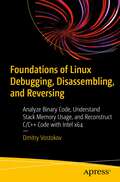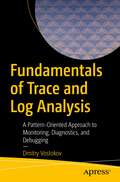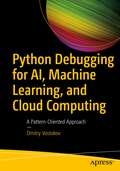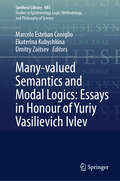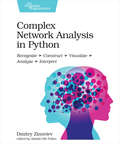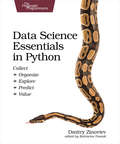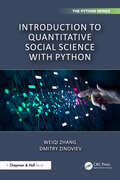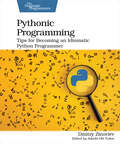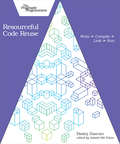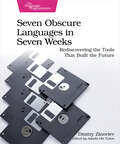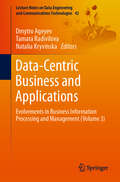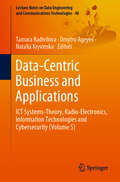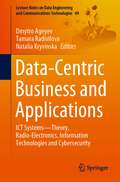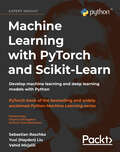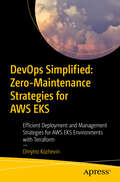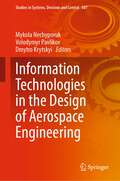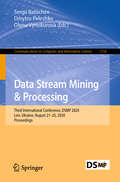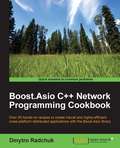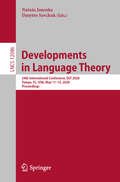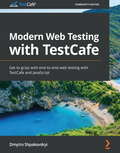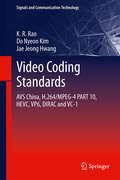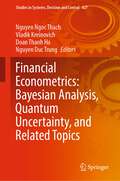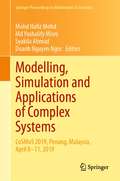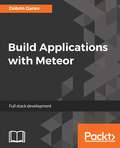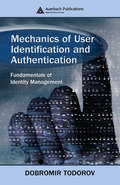- Table View
- List View
Foundations of Linux Debugging, Disassembling, and Reversing: Analyze Binary Code, Understand Stack Memory Usage, and Reconstruct C/C++ Code with Intel x64
by Dmitry VostokovReview topics ranging from Intel x64 assembly language instructions and writing programs in assembly language, to pointers, live debugging, and static binary analysis of compiled C and C++ code. This book is ideal for Linux desktop and cloud developers. Using the latest version of Debian, you’ll focus on the foundations of the diagnostics of core memory dumps, live and postmortem debugging of Linux applications, services, and systems, memory forensics, malware, and vulnerability analysis. This requires an understanding of x64 Intel assembly language and how C and C++ compilers generate code, including memory layout and pointers. This book provides the background knowledge and practical foundations you’ll need in order to master internal Linux program structure and behavior. It consists of practical step-by-step exercises of increasing complexity with explanations and ample diagrams. You’ll also work with the GDB debugger and use it for disassembly and reversing. By the end of the book, you will have a solid understanding of how Linux C and C++ compilers generate binary code. In addition, you will be able to analyze such code confidently, understand stack memory usage, and reconstruct original C/C++ code. Foundations of Linux Debugging, Disassembling, and Reversing is the perfect companion to Foundations of ARM64 Linux Debugging, Disassembling, and Reversing for readers interested in the cloud or cybersecurity.What You'll LearnReview the basics of x64 assembly languageExamine the essential GDB debugger commands for debugging and binary analysis Study C and C++ compiler code generation with and without compiler optimizations Look at binary code disassembly and reversing patternsSee how pointers in C and C++ are implemented and usedWho This Book Is ForSoftware support and escalation engineers, cloud security engineers, site reliability engineers, DevSecOps, platform engineers, software testers, Linux C/C++ software engineers and security researchers without Intel x64 assembly language background, beginners learning Linux software reverse engineering techniques, and engineers coming from non-Linux environments.
Fundamentals of Trace and Log Analysis: A Pattern-Oriented Approach to Monitoring, Diagnostics, and Debugging
by Dmitry VostokovThis book will help you analyze traces and logs from different software environments and communicate analysis results using a pattern language that covers everything from a small debugging log to a distributed trace with billions of messages from hundreds of computers, thousands of software components, threads, and processes. The book begins with the basic terminology of operating systems and programming, the foundation for understanding trace and log analysis. It then talks about patterns that help describe problems from a user’s view and patterns for errors and failures. Then, the book covers a range of trace patterns that group messages, and explores how logs depict software activities. It even examines specific message patterns and how they connect in a single trace. Moving forward, you’ll review patterns for multiple traces and logs and how to evaluate them. In this way, you can use similar methods to find problems across a wide variety of software. The book also provides guidance for analyzing issues on systems such as Windows, macOS, Linux, Android, iOS, and other types of computers, including those in networks and the Internet of Things, regardless of their system differences. Upon completing this book, you will be able to navigate the complexities of trace and log analysis and apply uniform diagnostics and anomaly detection pattern language across diverse software environments to help you troubleshoot, debug, and fix issues. What You Will Learn Understand pattern language for trace and log analysisGain a pattern-oriented methodology for trace and log analysis applicable to various domains, including cybersecurityMaster the fundamentals of operating systems and programming related to trace and log analysisUnderstand observed behavior in traces and logs, which aids incident response, diagnostics, root cause analysis, troubleshooting, and debugging Who This Book Is For Software technical support engineers, system and network administrators, software developers, testers, DevOps and DevSecOps, digital forensics and malware analysts, security incident response engineers, data analysts, and data mining practitioners.
Python Debugging for AI, Machine Learning, and Cloud Computing: A Pattern-Oriented Approach
by Dmitry VostokovThis book is for those who wish to understand how Python debugging is and can be used to develop robust and reliable AI, machine learning, and cloud computing software. It will teach you a novel pattern-oriented approach to diagnose and debug abnormal software structure and behavior. The book begins with an introduction to the pattern-oriented software diagnostics and debugging process that, before performing Python debugging, diagnoses problems in various software artifacts such as memory dumps, traces, and logs. Next, you’ll learn to use various debugging patterns through Python case studies that model abnormal software behavior. You’ll also be exposed to Python debugging techniques specific to cloud native and machine learning environments and explore how recent advances in AI/ML can help in Python debugging. Over the course of the book, case studies will show you how to resolve issues around environmental problems, crashes, hangs, resource spikes, leaks, and performance degradation. This includes tracing, logging, and analyziing memory dumps using native WinDbg and GDB debuggers. Upon completing this book, you will have the knowledge and tools needed to employ Python debugging in the development of AI, machine learning, and cloud computing applications. What You Will Learn Employ a pattern-oriented approach to Python debugging that starts with diagnostics of common software problemsUse tips and tricks to get the most out of popular IDEs, notebooks, and command-line Python debuggingUnderstand Python internals for interfacing with operating systems and external modulesPerform Python memory dump analysis, tracing, and logging Who This Book Is For Software developers, AI/ML engineers, researchers, data engineers, as well as MLOps and DevOps professionals.
Many-valued Semantics and Modal Logics: Essays in Honour of Yuriy Vasilievich Ivlev (Synthese Library #485)
by Marcelo Esteban Coniglio Dmitry Zaitsev Ekaterina KubyshkinaThis volume is a collection of essays related to the work of Professor Yuriy Vasilievich Ivlev, a distinguished Russian logician and philosopher renowned for his expertise in many-valued and modal logics. Notably, his groundbreaking work on quasi-matrices for logics, now recognized as non-deterministic matrices and non-deterministic semantics, emerged in the 1970s. From a philosophical standpoint, Ivlev’s research delves into the formal analysis of indeterminacy, offering a logical framework to understand how sequences of indeterminate events can yield determinate outcomes. The volume follows two complementary lines of research. Firstly, it serves as a platform for the exploration and discussion of Ivlev’s seminal contributions to the algebraic characterization of both normal and non-normal modal logics, aimed at making these insights accessible to an international audience. Secondly, it features contributions from esteemed logicians and philosophers worldwide, offering diverseperspectives on the logical analysis of indeterminacy. This comprehensive volume will appeal to scholars and researchers in logic, philosophy, and mathematics who are engaged in the study of many-valued and modal methodologies for modeling situations of indeterminacy.
Complex Network Analysis in Python: Recognize - Construct - Visualize - Analyze - Interpret
by Dmitry ZinovievConstruct, analyze, and visualize networks with networkx, a Python language module. Network analysis is a powerful tool you can apply to a multitude of datasets and situations. Discover how to work with all kinds of networks, including social, product, temporal, spatial, and semantic networks. Convert almost any real-world data into a complex network--such as recommendations on co-using cosmetic products, muddy hedge fund connections, and online friendships. Analyze and visualize the network, and make business decisions based on your analysis. If you're a curious Python programmer, a data scientist, or a CNA specialist interested in mechanizing mundane tasks, you'll increase your productivity exponentially. Complex network analysis used to be done by hand or with non-programmable network analysis tools, but not anymore! You can now automate and program these tasks in Python. Complex networks are collections of connected items, words, concepts, or people. By exploring their structure and individual elements, we can learn about their meaning, evolution, and resilience. Starting with simple networks, convert real-life and synthetic network graphs into networkx data structures. Look at more sophisticated networks and learn more powerful machinery to handle centrality calculation, blockmodeling, and clique and community detection. Get familiar with presentation-quality network visualization tools, both programmable and interactive--such as Gephi, a CNA explorer. Adapt the patterns from the case studies to your problems. Explore big networks with NetworKit, a high-performance networkx substitute. Each part in the book gives you an overview of a class of networks, includes a practical study of networkx functions and techniques, and concludes with case studies from various fields, including social networking, anthropology, marketing, and sports analytics. Combine your CNA and Python programming skills to become a better network analyst, a more accomplished data scientist, and a more versatile programmer. What You Need: You will need a Python 3.x installation with the following additional modules: Pandas (>=0.18), NumPy (>=1.10), matplotlib (>=1.5), networkx (>=1.11), python-louvain (>=0.5), NetworKit (>=3.6), and generalizesimilarity. We recommend using the Anaconda distribution that comes with all these modules, except for python-louvain, NetworKit, and generalizedsimilarity, and works on all major modern operating systems.
Data Science Essentials in Python: Collect - Organize - Explore - Predict - Value
by Dmitry ZinovievGo from messy, unstructured artifacts stored in SQL and NoSQL databases to a neat, well-organized dataset with this quick reference for the busy data scientist. Understand text mining, machine learning, and network analysis; process numeric data with the NumPy and Pandas modules; describe and analyze data using statistical and network-theoretical methods; and see actual examples of data analysis at work. This one-stop solution covers the essential data science you need in Python.Data science is one of the fastest-growing disciplines in terms of academic research, student enrollment, and employment. Python, with its flexibility and scalability, is quickly overtaking the R language for data-scientific projects. Keep Python data-science concepts at your fingertips with this modular, quick reference to the tools used to acquire, clean, analyze, and store data.This one-stop solution covers essential Python, databases, network analysis, natural language processing, elements of machine learning, and visualization. Access structured and unstructured text and numeric data from local files, databases, and the Internet. Arrange, rearrange, and clean the data. Work with relational and non-relational databases, data visualization, and simple predictive analysis (regressions, clustering, and decision trees). See how typical data analysis problems are handled. And try your hand at your own solutions to a variety of medium-scale projects that are fun to work on and look good on your resume.Keep this handy quick guide at your side whether you're a student, an entry-level data science professional converting from R to Python, or a seasoned Python developer who doesn't want to memorize every function and option.What You Need:You need a decent distribution of Python 3.3 or above that includes at least NLTK, Pandas, NumPy, Matplotlib, Networkx, SciKit-Learn, and BeautifulSoup. A great distribution that meets the requirements is Anaconda, available for free from www.continuum.io. If you plan to set up your own database servers, you also need MySQL (www.mysql.com) and MongoDB (www.mongodb.com). Both packages are free and run on Windows, Linux, and Mac OS.
Introduction to Quantitative Social Science with Python (Chapman & Hall/CRC The Python Series)
by Weiqi Zhang Dmitry ZinovievDeparting from traditional methodologies of teaching data analysis, this book presents a dual-track learning experience, with both Executive and Technical Tracks, designed to accommodate readers with various learning goals or skill levels. Through integrated content, readers can explore fundamental concepts in data analysis while gaining hands-on experience with Python programming, ensuring a holistic understanding of theory and practical application in Python.Emphasizing the practical relevance of data analysis in today's world, the book equips readers with essential skills for success in the field. By advocating for the use of Python, an open-source and versatile programming language, we break down financial barriers and empower a diverse range of learners to access the tools they need to excel.Whether you're a novice seeking to grasp the foundational concepts of data analysis or a seasoned professional looking to enhance your programming skills, this book offers a comprehensive and accessible guide to mastering the art and science of data analysis in social science research.Key Features: Dual-track learning: Offers both Executive and Technical Tracks, catering to readers with varying levels of conceptual and technical proficiency in data analysis. Includes comprehensive quantitative methodologies for quantitative social science studies. Seamless integration: Interconnects key concepts between tracks, ensuring a smooth transition from theory to practical implementation for a comprehensive learning experience. Emphasis on Python: Focuses on Python programming language, leveraging its accessibility, versatility, and extensive online support to equip readers with valuable data analysis skills applicable across diverse domains.
Pythonic Programming
by Dmitry ZinovievMake your good Python code even better by following proven and effective pythonic programming tips. Avoid logical errors that usually go undetected by Python linters and code formatters, such as frequent data look-ups in long lists, improper use of local and global variables, and mishandled user input. Discover rare language features, like rational numbers, set comprehensions, counters, and pickling, that may boost your productivity. Discover how to apply general programming patterns, including caching, in your Python code. Become a better-than-average Python programmer, and develop self-documented, maintainable, easy-to-understand programs that are fast to run and hard to break. Python is one of the most popular and rapidly growing modern programming languages. With more than 200 standard libraries and even more third-party libraries, it reaches into the software development areas as diverse as artificial intelligence, bioinformatics, natural language processing, and computer vision. Find out how to improve your understanding of the spirit of the language by using one hundred pythonic tips to make your code safer, faster, and better documented. This programming style manual is a quick reference of helpful hints and a random source of inspiration. Choose the suitable data structures for searching and sorting jobs and become aware of how a wrong choice may cause your application to be completely ineffective. Understand global and local variables, class and instance attributes, and information-hiding techniques. Create functions with flexible interfaces. Manage intermediate computation results by caching them in files and memory to improve performance and reliability. Polish your documentation skills to make your code easy for other programmers to understand. As a bonus, discover Easter eggs cleverly planted in the standard library by its developers. Polish, secure, and speed-up your Python applications, and make them easier to maintain by following pythonic programming tips. What You Need: You will need a Python interpreter (ideally, version 3.4 or above) and the standard Python library that usually comes with the interpreter.
Resourceful Code Reuse
by Dmitry ZinovievReusing well-written, well-debugged, and well-tested code improves productivity, code quality, and software configurability and relieves pressure on software developers. When you organize your code into self-contained modular units, you can use them as building blocks for your future projects and share them with other programmers, if needed. Understand the benefits and downsides of seven code reuse models so you can confidently reuse code at any development stage. Create static and dynamic libraries in C and Python, two of the most popular modern programming languages. Adapt your code for the real world: deploy shared functions remotely and build software that accesses them using remote procedure calls. Avoid the drawbacks and harness the benefits associated with seven code reuse models. Create static and dynamic libraries in C and Python, deploy shared functions remotely, and build software that makes intelligent use of remote procedure calls. In no time at all, you'll develop the confidence to reuse code at any stage of real-world development. This one-stop solution covers the complete build cycle: editing, compiling, linking, and running a ready program. Apply Linux/macOS power software development tools, such as ld, ldd, ranlib, and nm, to construct and explore state-of-the-art function libraries in C that could be linked with application-specific code either permanently or for the duration of execution. Learn why Python has modules for reuse and how they differ from C object files and libraries. Understand the risks and other negative implications of sharing and reuse. As a bonus, distill the dependencies between your project's components and automate and optimize your build process with the "make" utility. Whether you are an amateur coder or an experienced developer, become a more productive and resourceful programmer by reusing previously written code. What You Need: To compile and run the C examples mentioned in the book, you need a decent C compiler (GCC is the best, but Intel and Microsoft would probably work, too) and a set of C development tools: maker (make), linker (ld), file, strip, ldd, and ranlib. Again, the GNU development toolset works marvels; other toolsets may or may not work. All examples in the book have been tested on a Linux computer but will most likely work on macOS. For the Python examples, a Python-3.x interpreter is all you want. No third-party modules are required.
Seven Obscure Languages in Seven Weeks
by Dmitry ZinovievImmerse yourself in the intricate world of forgotten programming languages with Seven Obscure Languages in Seven Weeks. This comprehensive guide serves as a bridge to understanding and revitalizing legacy code, offering invaluable insights into the evolution of programming. With hands-on tutorials spanning languages from Forth and Simula to SNOBOL and m4, readers are equipped to maintain older systems and gain a broader perspective on problem-solving techniques. Whether you are a seasoned developer, a software historian, or just curious about the roots of modern coding, this book illuminates the rich tapestry of programming's past and sheds light on its present and future.Venture into overlooked and long-forgotten programming languages that once stood at the forefront of technological innovation. From the stack-oriented design of Forth to the early object-oriented experiences in Simula, bridge the ever-widening chasm between contemporary code and legacy systems. If you find yourself ensnared by the challenges of updating or maintaining older systems, this book is the lifeline.Unravel the fabric of seven programming languages by following practical tutorials and building small applications. Find out how Simula led to C++, what made APL so powerful, and why we still use m4 even to this day. Along the way, you'll broaden your problem-solving horizons, and develop diverse approaches to computation that still ripple through today's coding landscape. By the final chapter, you won't merely possess historical knowledge, you'll be equipped with production ready skills capable of tackling projects that interface with legacy code.Trace the evolutionary lineage of programming to gain a predictive edge in anticipating future trends. After all, this isn't just a nostalgic trip - it's a roadmap to the past, present, and future of coding.What You Need:Various software tools and compilers are available for enthusiasts eager to explore the once-forgotten languages detailed in this book. Guidance is provided primarily for Linux users on accessing these older programming languages. This collection includes languages like m4, integral to the GNU Autoconf system, and other languages incorporated into the GNU ecosystem, such as APL, Forth, and Simula. For those with a penchant for nostalgia, there is the SNOBOL4.2, which can run using the DOSBox MS-DOS emulator. KRoC, an Occam compiler, works only with 32-bit architectures or in a docker. Suffolk University maintains Starset's modern implementation. Readers can find links to repositories of these development tools, ensuring they can fully immerse themselves in this intriguing journey.
Data-Centric Business and Applications: Evolvements in Business Information Processing and Management (Volume 3) (Lecture Notes on Data Engineering and Communications Technologies #42)
by Natalia Kryvinska Dmytro Ageyev Tamara RadivilovaBuilding on the authors’ previous work, this book addresses key processes and procedures used in information/data processing and management. Modern methods of business information processing, which draw on artificial intelligence, big data, and cloud-based storage and processing, are opening exciting new opportunities for doing business on the basis of information technologies. Thus, in this third book, the authors continue to explore various aspects – technological as well as business and social – of the information industries. Further, they analyze the challenges and opportunities entailed by these kinds of business.
Data-Centric Business and Applications: ICT Systems-Theory, Radio-Electronics, Information Technologies and Cybersecurity (Volume 5) (Lecture Notes on Data Engineering and Communications Technologies #48)
by Natalia Kryvinska Dmytro Ageyev Tamara RadivilovaThis book addresses the challenges and opportunities of information/data processing and management. It also covers a range of methods, techniques and strategies for making it more efficient, approaches to increasing its usage, and ways to minimize information/data loss while improving customer satisfaction. Information and Communication Technologies (ICTs) and the Service Systems associated with them have had an enormous impact on businesses and our day-to-day lives over the past three decades, and continue to do so. This development has led to the emergence of new application areas and relevant disciplines, which in turn present new challenges and opportunities for service system usage. The book provides practical insights into various aspects of ICT technologies for service systems: Techniques for information/data processing and modeling in service systems Strategies for the provision of information/data processing and management Methods for collecting and analyzing information/data Applications, benefits, and challenges of service system implementation Solutions to increase the performance of various service systems using the latest ICT technologies
Data-Centric Business and Applications: ICT Systems—Theory, Radio-Electronics, Information Technologies and Cybersecurity (Lecture Notes on Data Engineering and Communications Technologies #69)
by Natalia Kryvinska Dmytro Ageyev Tamara RadivilovaThis book, building on the authors’ previous work, presents new communication and networking technologies, challenges and opportunities of information/data processing and transmission. It also discusses the development of more intelligent and efficient communication technologies, which are an essential part of current day-to-day life. Information and Communication Technologies (ICTs) have an enormous impact on businesses and our day-to-day lives over the past three decades and continue to do so. Modern methods of business information processing are opening exciting new opportunities for doing business on the basis of information technologies. The book contains research that spans a wide range of communication and networking technologies, including wireless sensor networks, optical and telecommunication networks, storage area networks, error-free transmission and signal processing.
Machine Learning with PyTorch and Scikit-Learn: Develop machine learning and deep learning models with Python
by Sebastian Raschka Vahid Mirjalili Yuxi (Hayden) Liu Dmytro DzhulgakovThis book of the bestselling and widely acclaimed Python Machine Learning series is a comprehensive guide to machine and deep learning using PyTorch's simple to code frameworkKey FeaturesLearn applied machine learning with a solid foundation in theoryClear, intuitive explanations take you deep into the theory and practice of Python machine learningFully updated and expanded to cover PyTorch, transformers, XGBoost, graph neural networks, and best practicesBook DescriptionMachine Learning with PyTorch and Scikit-Learn is a comprehensive guide to machine learning and deep learning with PyTorch. It acts as both a step-by-step tutorial and a reference you'll keep coming back to as you build your machine learning systems.Packed with clear explanations, visualizations, and examples, the book covers all the essential machine learning techniques in depth. While some books teach you only to follow instructions, with this machine learning book, we teach the principles allowing you to build models and applications for yourself.Why PyTorch?PyTorch is the Pythonic way to learn machine learning, making it easier to learn and simpler to code with. This book explains the essential parts of PyTorch and how to create models using popular libraries, such as PyTorch Lightning and PyTorch Geometric.You will also learn about generative adversarial networks (GANs) for generating new data and training intelligent agents with reinforcement learning. Finally, this new edition is expanded to cover the latest trends in deep learning, including graph neural networks and large-scale transformers used for natural language processing (NLP).This PyTorch book is your companion to machine learning with Python, whether you're a Python developer new to machine learning or want to deepen your knowledge of the latest developments.What you will learnExplore frameworks, models, and techniques for machines to 'learn' from dataUse scikit-learn for machine learning and PyTorch for deep learningTrain machine learning classifiers on images, text, and moreBuild and train neural networks, transformers, and boosting algorithmsDiscover best practices for evaluating and tuning modelsPredict continuous target outcomes using regression analysisDig deeper into textual and social media data using sentiment analysisWho this book is forIf you know some Python and you want to use machine learning and deep learning, pick up this book. Whether you want to start from scratch or extend your machine learning knowledge, this is an essential resource.Written for developers and data scientists who want to create practical machine learning with Python and PyTorch deep learning code. This Python book is ideal for anyone who wants to teach computers how to learn from data.Working knowledge of the Python programming language, along with a good understanding of calculus and linear algebra is a must.
DevOps Simplified: Efficient Deployment and Management Strategies for AWS EKS Environments with Terraform
by Dmytro KozhevinGain the knowledge and practical skills needed to deploy a fully functional, secure, and scalable application in AWS EKS. This book is a hands-on guide designed to help you navigate and manage infrastructure in the AWS EKS environment. The book starts by reviewing the concept of DevOps flexibility, emphasizing adaptability to manage changes effectively. It covers foundational elements like IAM basics, user management, and the use of Terraform for infrastructure as code, highlighting the importance of version stability and unique CIDR blocks. Moving forward, you’ll explore Kubernetes, and its initial set-up steps, such as configuration management, access control, and storage. You’ll also see how to bridge Kubernetes with AWS resources, touching upon service accounts, identity federation, and policy assignment. In the final chapters, the book guides you through the complete setup of a fully working application using Terraform. The book culminates with a step-by-step walkthrough of deploying a complete application environment where you’ll generate and distribute access credentials, configure persistent storage, and manage RBAC for users, all using Terraform. Zero-Maintenance Strategies for AWS EKS will provide you with a solid foundation and a toolkit of proven strategies for managing cloud infrastructure. What You Will Learn Understand the concept of DevOps flexibility and its practical applications Acquire foundational knowledge in IAM basics and user management. Manage external access to your applications while consolidating load balancing through a single, entry point. Securely configure DNS and SSL, ensuring your application is both accessible and protected. Who This Book Is For DevOps professionals, IT managers, and software developers who are looking to adopt or improve their DevOps practices, and students and educators in IT-related fields.
Information Technologies in the Design of Aerospace Engineering (Studies in Systems, Decision and Control #507)
by Mykola Nechyporuk Volodymyr Pavlikov Dmytro KrytskyiThis book proposes a solution to the problem of incorrect use of automation tools to perform complex design work. Currently, a large number of start-up projects are non-professional design bureaus that show a huge amount of their achievements. In reality, most of these achievements burst like soap bubbles. This is due to the low-quality and inefficient use of information technology in this industry. The book highlights advanced information technologies in the fields of design, machine learning, and computer vision.
Data Stream Mining & Processing: Third International Conference, DSMP 2020, Lviv, Ukraine, August 21–25, 2020, Proceedings (Communications in Computer and Information Science #1158)
by Sergii Babichev Olena Vynokurova Dmytro PeleshkoThis book constitutes the proceedings of the third International Conference on Data Stream and Mining and Processing, DSMP 2020, held in Lviv, Ukraine*, in August 2020.The 36 full papers presented in this volume were carefully reviewed and selected from 134 submissions. The papers are organized in topical sections of hybrid systems of computational intelligence; machine vision and pattern recognition; dynamic data mining & data stream mining; big data & data science using intelligent approaches.*The conference was held virtually due to the COVID-19 pandemic.
Boost.Asio C++ Network Programming Cookbook
by Dmytro RadchukOver 25 hands-on recipes to create robust and highly-efficient cross-platform distributed applications with the Boost.Asio library About This Book * Build highly efficient distributed applications with ease * Enhance your cross-platform network programming skills with one of the most reputable C++ libraries * Find solutions to real-world problems related to network programming with ready-to-use recipes using this detailed and practical handbook Who This Book Is For If you want to enhance your C++ network programming skills using the Boost.Asio library and understand the theory behind development of distributed applications, this book is just what you need. The prerequisite for this book is experience with general C++11. To get the most from the book and comprehend advanced topics, you will need some background experience in multithreading. What You Will Learn * Boost your working knowledge of one of the most reputable C++ networking libraries--Boost.Asio * Familiarize yourself with the basics of TCP and UDP protocols * Create scalable and highly-efficient client and server applications * Understand the theory behind development of distributed applications * Increase the security of your distributed applications by adding SSL support * Implement a HTTP client easily * Use iostreams, scatter-gather buffers, and timers In Detail Starting with recipes demonstrating the execution of basic Boost.Asio operations, the book goes on to provide ready-to-use implementations of client and server applications from simple synchronous ones to powerful multithreaded scalable solutions. Finally, you are presented with advanced topics such as implementing a chat application, implementing an HTTP client, and adding SSL support. All the samples presented in the book are ready to be used in real projects just out of the box. As well as excellent practical examples, the book also includes extended supportive theoretical material on distributed application design and construction. Style and approach This book is a set of recipes, each containing the statement and description of a particular practical problem followed by code sample providing the solution to the problem and detailed step-by-step explanation. Recipes are grouped by topic into chapters and ordered by the level of complexity from basic to advanced.
Developments in Language Theory: 24th International Conference, DLT 2020, Tampa, FL, USA, May 11–15, 2020, Proceedings (Lecture Notes in Computer Science #12086)
by Nataša Jonoska Dmytro SavchukThis book constitutes the proceedings of the 24th International Conference on Developments in Language Theory, DLT 2020, which was due to be held in Tampa, Florida, USA, in May 2020. The conference was cancelled due to the COVID-19 pandemic. The 24 full papers presented were carefully reviewed and selected from 38 submissions. The papers present current developments in language theory, formal languages, automata theory and related areas, such as algorithmic, combinatorial, and algebraic properties of words and languages, cellular automata, algorithms on words, etc.
Modern Web Testing with TestCafe: Get to grips with end-to-end web testing with TestCafe and JavaScript
by Dmytro ShpakovskyiThe book is for QA professionals, test engineers, software engineers, and test automation enthusiasts looking for hands-on guidance on learning about TestCafe. This book is also great for full-stack developers who want to learn more about new tools for testing their code. The book assumes a basic understanding of JavaScript, Node.js, HTML, and CSS.
Video coding standards
by Jae Jeong Hwang K. R. Rao Do Nyeon KimThe requirements for multimedia (especially video and audio) communications increase rapidly in the last two decades in broad areas such as television, entertainment, interactive services, telecommunications, conference, medicine, security, business, traffic, defense and banking. Video and audio coding standards play most important roles in multimedia communications. In order to meet these requirements, series of video and audio coding standards have been developed such as MPEG-2, MPEG-4, MPEG-21 for audio and video by ISO/IEC, H. 26x for video and G. 72x for audio by ITU-T, Video Coder 1 (VC-1) for video by the Society of Motion Picture and Television Engineers (SMPTE) and RealVideo (RV) 9 for video by Real Networks. AVS China is the abbreviation for Audio Video Coding Standard of China. This new standard includes four main technical areas, which are systems, video, audio and digital copyright management (DRM), and some supporting documents such as consistency verification. The second part of the standard known as AVS1-P2 (Video - Jizhun) was approved as the national standard of China in 2006, and several final drafts of the standard have been completed, including AVS1-P1 (System - Broadcast), AVS1-P2 (Video - Zengqiang), AVS1-P3 (Audio - Double track), AVS1-P3 (Audio - 5. 1), AVS1-P7 (Mobile Video), AVS-S-P2 (Video) and AVS-S-P3 (Audio). AVS China provides a technical solution for many applications such as digital broadcasting (SDTV and HDTV), high-density storage media, Internet streaming media, and will be used in the domestic IPTV, satellite and possibly the cable TV market. Comparing with other coding standards such as H. 264 AVC, the advantages of AVS video standard include similar performance, lower complexity, lower implementation cost and licensing fees. This standard has attracted great deal of attention from industries related to television, multimedia communications and even chip manufacturing from around the world. Also many well known companies have joined the AVS Group to be Full Members or Observing Members. The 163 members of AVS Group include Texas Instruments (TI) Co. , Agilent Technologies Co. Ltd. , Envivio Inc. , NDS, Philips Research East Asia, Aisino Corporation, LG, Alcatel Shanghai Bell Co. Ltd. , Nokia (China) Investment (NCIC) Co. Ltd. , Sony (China) Ltd. , and Toshiba (China) Co. Ltd. as well as some high level universities in China. Thus there is a pressing need from the instructors, students, and engineers for a book dealing with the topic of AVS China and its performance comparisons with similar standards such as H. 264, VC-1 and RV-9.
Financial Econometrics: Bayesian Analysis, Quantum Uncertainty, and Related Topics (Studies in Systems, Decision and Control #427)
by Vladik Kreinovich Nguyen Ngoc Thach Nguyen Duc Trung Doan Thanh HaThis book overviews latest ideas and developments in financial econometrics, with an emphasis on how to best use prior knowledge (e.g., Bayesian way) and how to best use successful data processing techniques from other application areas (e.g., from quantum physics). The book also covers applications to economy-related phenomena ranging from traditionally analyzed phenomena such as manufacturing, food industry, and taxes, to newer-to-analyze phenomena such as cryptocurrencies, influencer marketing, COVID-19 pandemic, financial fraud detection, corruption, and shadow economy. This book will inspire practitioners to learn how to apply state-of-the-art Bayesian, quantum, and related techniques to economic and financial problems and inspire researchers to further improve the existing techniques and come up with new techniques for studying economic and financial phenomena. The book will also be of interest to students interested in latest ideas and results.
Modelling, Simulation and Applications of Complex Systems: CoSMoS 2019, Penang, Malaysia, April 8-11, 2019 (Springer Proceedings in Mathematics & Statistics #359)
by Mohd Hafiz Mohd Md Yushalify Misro Syakila Ahmad Doanh Nguyen NgocThis book discusses the latest progresses and developments on complex systems research and intends to give an exposure to prospective readers about the theoretical and practical aspects of mathematical modelling, numerical simulation and agent-based modelling frameworks. The main purpose of this book is to emphasize a unified approach to complex systems analysis, which goes beyond to examine complicated phenomena of numerous real-life systems; this is done by investigating a huge number of components that interact with each other at different (microscopic and macroscopic) scales; new insights and emergent collective behaviours can evolve from the interactions between individual components and also with their environments. These tools and concepts permit us to better understand the patterns of various real-life systems and help us to comprehend the mechanisms behind which distinct factors shaping some complex systems phenomena being influenced.This book is published in conjunction with the International Workshop on Complex Systems Modelling & Simulation 2019 (CoSMoS 2019): IoT & Big Data Integration. This international event was held at the Universiti Sains Malaysia Main Campus, Penang, Malaysia, from 8 to 11 April 2019. This book appeals to readers interested in complex systems research and other related areas such as mathematical modelling, numerical simulation and agent-based modelling frameworks.
Build Applications with Meteor
by Dobrin GanevBuild a variety of cross-platform applications with the world's most complete full-stack JavaScript framework— Meteor About This Book • Develop a set of real-world applications each exploring different features of Meteor • Make your app more appealing by adding reactivity and responsiveness to it • Work with the most powerful feature of Meteor—the “full stack reactivity”—through building real-time applications with many third party libraries Who This Book Is For If you are a developer who is looking forward to taking your application development skills with Meteor to next level by getting your hands-on different projects, this book is for you. What You Will Learn • See how Meteor fits in the modern web application development by using its reactive data system • Make your front-end behave consistently across environments by implementing a predictable state container with Redux • Get familiar with React and overview of Angular 2 • Add a map to your application with a real-time geolocation • Plugin into Meteor social media APIs like Twitter's streaming and Facebook's Messenger • Add search functionality from scratch to your existing app and data • Add responsiveness with Bootstrap 4 and Google's Material Design using Less and Sass • Distribute your data across machines and data centers by adding Apache Cassandra to your existing stack. • Learn how to scale your microservices with the high performant language neutral framework gRPC. • Learn how to query multiple data sources using GraphQL. In Detail This book starts with the basic installation and overview of the main components in Meteor. You'll get hands-on multiple versatile applications covering a wide range of topics from adding a front-end views with the hottest rendering technology React to implementing a microservices oriented architecture.All the code is written with ES6/7 which is the latest significantly improved JavaScript language. We'll also look at real-time data streaming, server to server data exchange, responsive styles on the front-end, full-text search functionality, and integration of many third-party libraries and APIs using npm. By the end of the book, you'll have the skills to quickly prototype and even launch your next app idea in a matter of days. Style and Approach This book takes an easy-to-follow project-based approach. Each project starts with the goal of what you will learn and an overview the technologies used.
Mechanics of User Identification and Authentication: Fundamentals of Identity Management
by Dobromir TodorovUser identification and authentication are absolutely essential to modern security. Mechanics of User Identification and Authentication presents the general philosophy of user authentication and access control. Introducing key concepts, this text outlines the process of controlled access to resources through authentication, authorization, and accounting. It provides specific information on the user authentication process for both UNIX and Windows. Addressing more advanced applications and services, the author presents common security models such as GSSAPI and discusses authentication architecture. Each method is presented with a specific authentication scenario.
